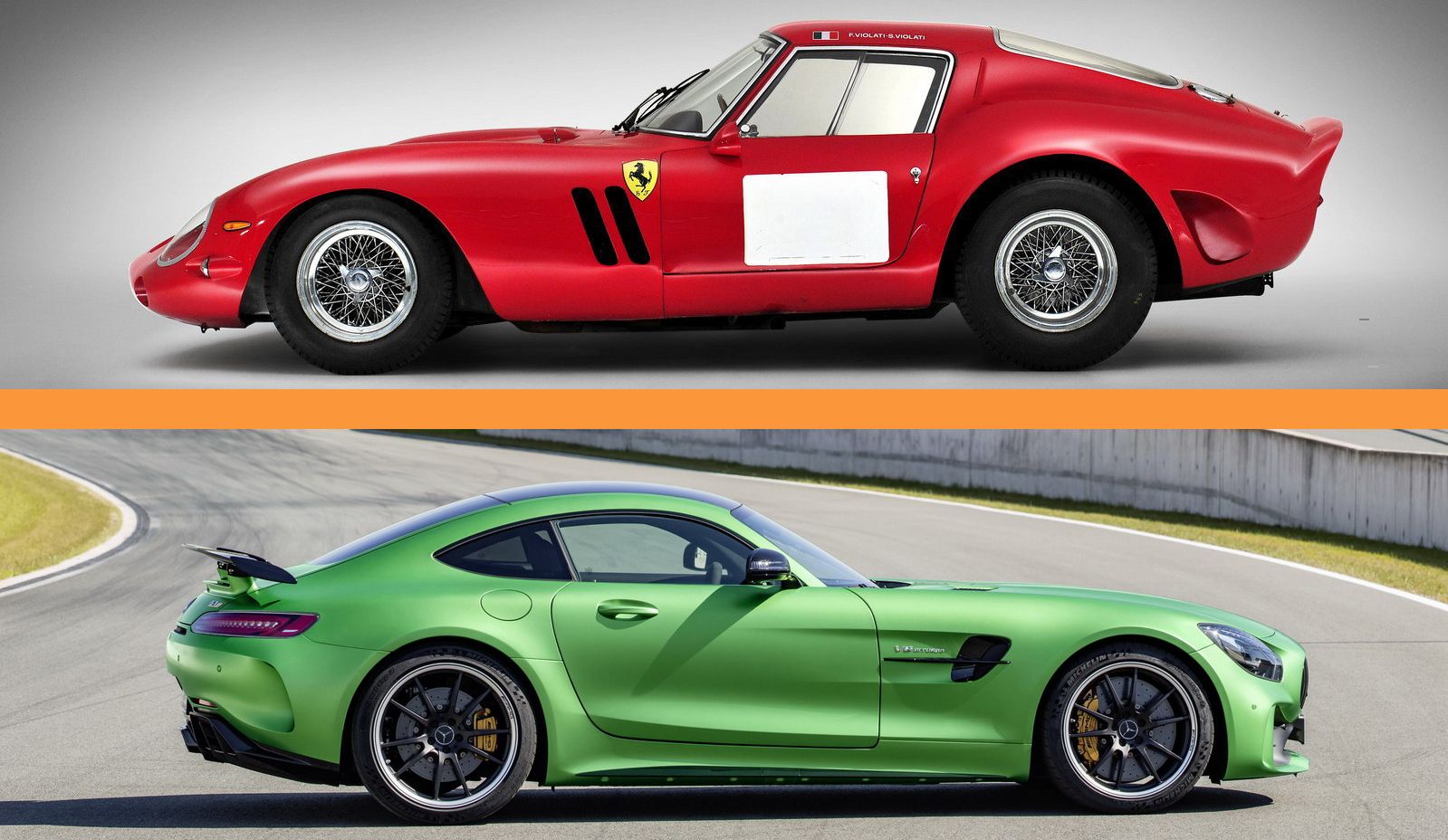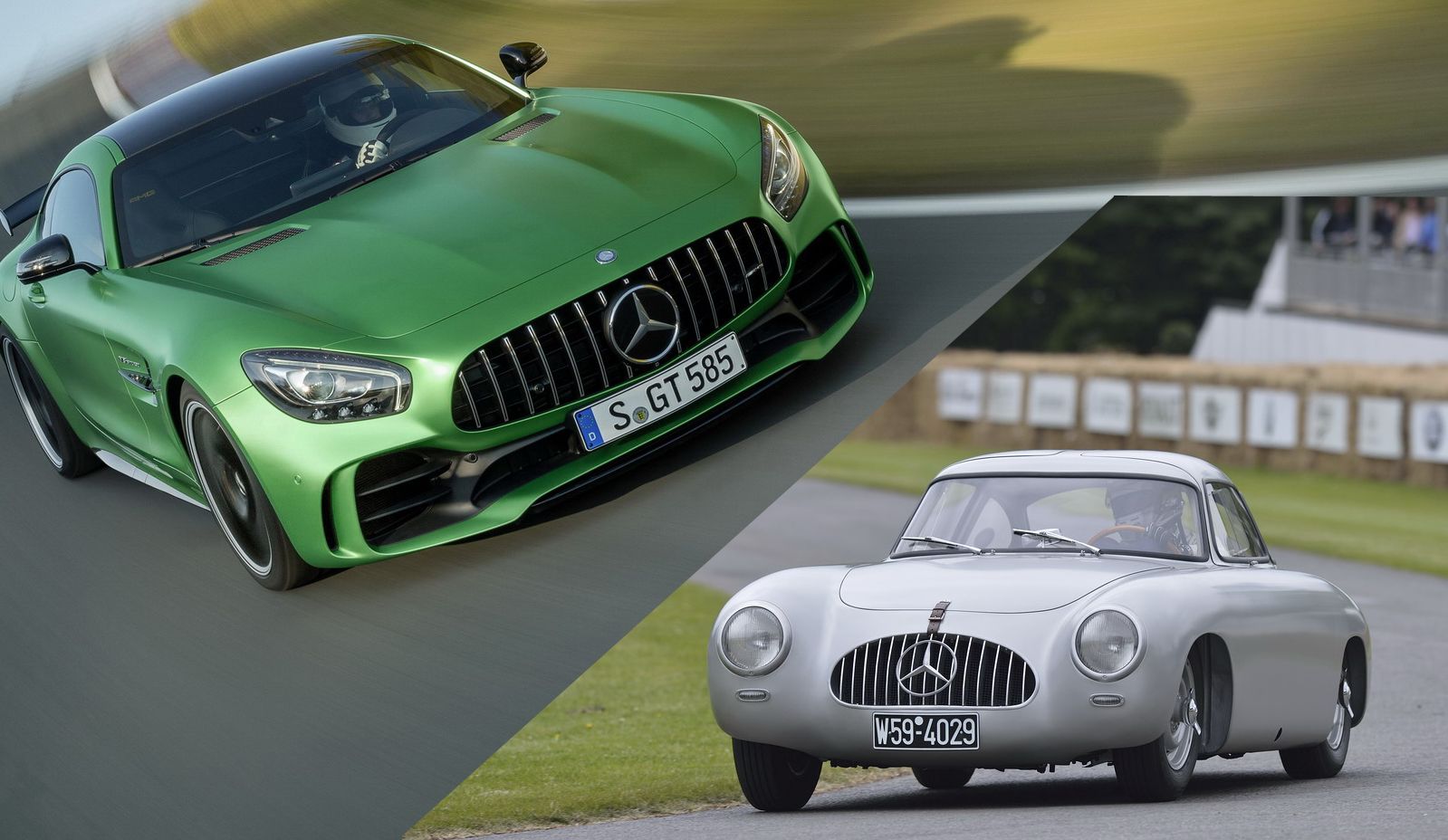When Porsche introduced the 911 GT3 in 1999, it established a new niche of road-legal sports cars designed for the race track. Although the concept behind the GT3 wasn't exactly new -- it's part of a line of high-performance models that goes back to the 1973 911 Carrera RS -- the amount of race-bred components poured into the car was unprecedented. The fact that the track-oriented 911 was named after the FIA's Group GT3 class also helped cement Porsche's position at the top of the industry. The 911 GT3 has evolved dramatically since then and spawned even quicker and more powerful versions throughout its career. But, other automakers began to follow the same route and have launched strong competitors for Porsche's range-topping, naturally aspirated coupe.
The latest to join these ranks is Mercedes-Benz, which unleashed the AMG GT R for the 2018 model year.
As the name suggests, it is a beefed-up version of the Mercedes-AMG GT, a sports coupe specifically developed to compete against the Porsche 911 Turbo. However, the GT R is not only quicker and more powerful than the standard GT, it's also equipped with a massive amount of race-bred components, complemented by a body kit that's nearly identical to the Mercedes-AMG GT3 race car. As you might have already guessed, the GT R was conceived to give the mighty 911 GT3 a run for its money.
But, does it have what it takes to compete against one of the most exciting sports cars ever built? I think so, and I put together five reasons why the GT R will make the 911 GT3 look over its shoulder in years to come.
Continue reading for the full story.
Classic GT Layout
Have you noticed how most sports cars and supercars come with a mid-ship engine layout nowadays? Well, this wasn't the case a few decades ago. Before the Lamborghini Miura made the mid-engined concept popular in the mid-1960s, all sports car had their powerplants mounted between the driver and the front axle. Sure, you could argue that that modern sports cars such as the Alfa Romeo 4C, Jaguar F-Type, and Chevrolet Corvette also have their engines in the front, but these are also different than the classic configuration, which involved a long hood and a really short deck lid.
To get a better idea of what I'm talking about just take a look at the iconic Ferrari 250 GTO. While it may sound ludicrous nowadays, it was cars like the 250 GTO that dominated the race tracks and gathered the most attention at auto shows back in the day. Long front hoods with big engines underneath were the norm, and although it's fair to point out that the mid-engine layout was a big step forward as far as performance goes, the front-engine design is by no means dated. And, with so many manufacturers dropping the powerplant behind the seats nowadays, the AMG GT R is a welcomed addition that somewhat adds a bit of diversity to the modern sports car market.
More so since there aren't any full-fledged, track-prepped sports cars using this configuration out there. Granted, there are plenty of front-engined, high-performance models to choose from, but none bring together the grand tourer body style and the race-inspired performance better than the AMG GT R. If you want horsepower, you can always go with the Aston Martin V12 Vantage. Need better handling? Check out the Jaguar F-Type SVR. Need both in a car that's as sleek as a proper GT and delivers the thrills you can only get in a race car? Well, that's a mission for the AMG GT R. To be fair, there's also the Ferrari F12berlinetta, but the $300,000+ sticker takes it out of the average Joe's reach.
Needless to say, the long-hooded, GT configuration doesn't make the AMG GT R quicker or more agile than the 911 GT3, but it makes it unique and turns in into a tribute for the classic sports car layout hardcore enthusiasts have come to appreciate.
Harkens Back to the 300SL
Speaking of classic sports cars, the Mercedes-AMG GT was, much like the SLS AMG, designed with the 1954 300 SL in mind. Although it is part of the SL-Class series, which has been produced continuously over five generations as of 2016, the 300 SL has remained a unique car since its discontinuation in 1963. The AMG GT bears an uncanny resemblance to the first-generation SL. The long hood, the short deck lid, the GT layout, and the powerful stance are all there. And, this is no coincidence. At some point, the folks over at Mercedes-Benz realized that their modern products have very little in common with the brand's legendary cars from the 1960s, and designed the SLS AMG and the SLR McLaren accordingly. And, even though the AMG GT doesn't have the SLS' "gullwing" doors, it's a more accurate interpretation of the 300 SL.
The historic relationship became a lot more interesting with the AMG GT R, which harkens back to the W194, or the race car from which the road-going 300 SL was derived. Mercedes-Benz was quick to brag about this by saying that the R's larger grille with vertical slats is based on the 300 SL race car that won the legendary Panamericana road race in Mexico in 1952, but that's more than just fancy PR talk. The ressemblance is again noteworthy, with the "AMG Panamericana" being just one of the many design features shared between the two. Along with the styling also comes a big chunk of racing heritage, as the 300 SL won not only the Carrera Panamericana, but also the 24 Hours of Le Mans and the Mille Miglia. What's more, it was driven by high-profile drivers such as Juan Manuel Fangio and Stirling Moss.
That's something you don't get with the 911 GT3, and even though I'm a big fan of the Porsche and I'm just crazy about the 2.7 RS that started it all in the 1970s, there's something about the grueling race of the 1950s that make the 300 SL such a turn on for me.
Drop Dead Gorgeous
Classic GT configuration and 300 SL-inspired styling cues aside, the GT R is plain gorgeous to look at, which can't be said about the many track-oriented sports cars available right now. Track-prepped cars are developed for ground-breaking performance, an attribute that rarely goes hand in hand with an attractive design. Enhancing aerodynamics and reducing drag often requires radical body kits and significant alterations to the standard model's styling, which is why cars like the 911 GT3 no longer sport the sleek and elegant shape of their road-going siblings. The AMG GT R is an exception from this rule because Mercedes managed to inject steroids into the coupe without diminishing its overall GT appearance.
Sure, the massive front grille and bumper vents give it a significantly more menacing appearance, but the wider fenders and beefy side skirts are blended seamlessly into the GT's design. It's like the coupe was specifically developed for this race-inspired kit, which is probably exactly what happened knowing the amount of development that goes into an AMG. What's also amazing is that Mercedes managed to add a rear wing that small, but effective, finding the optimal balance between downforce and decency. Not that I have something against big rear wings -- I like a bit of junk in the trunk if you know what I mean -- but the 911 GT3 is a bit too obvious with that massive element on its engine lid. The AMG GT R, on the other hand, is both sexy and inconspicuous.
Track-Bred Technology
Moving onto the technology behind the AMG GT R, Mercedes-Benz is basically offering a race car for the road. The coupe features a massive array of race-bred components, starting with the increased track width for optimum grip and higher cornering speeds. Also contributing to the cars incredible grip is the double rear diffuser, which also enhances aerodynamic efficiency.
The nine-way adjustable traction control and the adjustable coil-over suspension with additional electronic control enable the driver to create a wide variety of setups, as well as adjust the spring pre-load manually. This is not similar, but identical to what professional motorsport drivers can do with their full-blown race cars. The driver can also adjust the adaptive damping characteristics at the touch of a button by using the AMG Dynamic Select drive modes. Three modes are available: "Comfort", "Sport" and "Sport Plus". While "Comfort" is the right choice for public roads, "Sport" is more suitable for difficult race tracks such as Nurburgring, delivering a highly dynamic driving with maximum ground contact through the bends. "Sport Plus" is ideal for flatter, modern race circuits such as Hockenheim, where a high degree of structural rigidity is most important. Impressive!
But wait, there's more.
The wishbones, steering knuckles and hub carriers on the front and rear axle are manufactured entirely out of forged aluminium, while the uniball spherical bearings on the lower wishbones of the rear axle are significantly more wear-resistant than wishbone bushings are due to their toe-in and camber parameters not changing under high loads.
Next up is the rear-axle steering system. Although not exactly new, being offered on the 911 GT3 for quite a few years, AMG claims that the GT R' offers "an ideal combination of agility and stability" -- two handling characteristics that are normally in direct conflict. Up to a speed of 62 mph, the rear wheels are turned in the opposite direction to the front wheels, which virtually shortens the wheelbase, resulting in increased agility and less steering effort, especially on narrow race tracks. When speed exceeds 62 mph, the system turns the rear wheels in the same direction as the front wheels, corresponding to a virtual lengthening of the wheelbase, thus improving handling stability and building up lateral G forces considerably faster when changing direction. This returns quicker steering inputs and delivers massive grip on the rear axle.
Torsional stiffness also plays a key role at the track, and the AMG GT R is equipped with features currently not available on other road-going models. First, it has a carbon-fiber torque tube that weighs only 30.6 pounds and is about 40 percent lighter than its aluminum counterpart in the standard AMG GT. Second, there's a new carbon-fiber tunnel cross that replaces three different aluminum components. This element is mounted under the exhaust system and the torque tube and further stiffens the body for withstanding the high torsional loads that occur during racing. It does so by bracing the two vehicle sides against each other, increasing the torsional rigidity by around 7.5 percent.
It's obvious that Mercedes-AMG made no compromise in this department.
Active Aerodynamics
Aerodynamics are yet another aspect that enables the AMG GT R to stand out among the track-oriented sports cars currently available on the market. The coupe is packed with active aerodynamic elements, starting with what AMG calls "air curtains." Mounted on the outside of the front fascia these devices calm the airflow, improving the cars Cd value, and guides the air towards the wheel arches, further optimizing the flow. The new and unique wheel arch liners with special cooling slits also help provide ideal airflow parameters.
But, arguably, the most interesting feature is the active carbon-fiber profile concealed in the underbody, just in front of the engine. This device moves downward by about 1.5 inches at a speeds higher than 50 mph in "Race" mode, changing the airflow and creating the Venturi effect, which "sucks" the car onto the road and reduces the front-axle lift by around 88 pounds at 155 mph. This results in more precise steering when cornering at high speed and better directional stability, especially during fast cornering and under high lateral acceleration.
Another technical highlight improving the aerodynamics of the AMG GT R is the active air management system, which consists of vertical louvers positioned in the lower area behind the front fascia. These elements are electronically controlled and can be opened and closed in around a second by an electric motor for improved airflow and aerodynamic performance.
When closed, which occurs at high speed, during braking, and when cornering at high speed, the louvers lower drag and route the air to the underbody to reduce front lift. When certain components have reached predefined temperatures and the demand for cooling air is high, the louvers open and allow the maximum amount of cooling air to flow toward the heat exchangers.
Besides their individual contribution to the car's aerodynamics, all the features above also help increase the surface contact at top speed by a whopping 341.7 pounds, compared to the standard AMG GT.
Conclusion
The purpose of this article is not to point out the AMG GT R as a more potent alternative to the 911 GT3, but to underline that the Porsche may no longer be the single best alternative for those looking for a full-fledged race car that can be driven on public roads and has a sub-$200,000 sticker. Granted, the 911 GT3 still has certain advantages over the GT R -- it is lighter and quicker -- but the Merc is loaded with all the technology that the current market demands from a high-end sports car. More and more customers are looking for the ultimate, supercar-like experience in a somewhat affordable sports car, and the AMG GT R delivers just that (at least on paper). Couple that with the traditional GT layout and the spiritual link with the successful 300 SL race car, and the AMG GT R become the ultimate road-legal track machine that won't tear your bank account to shreds.




